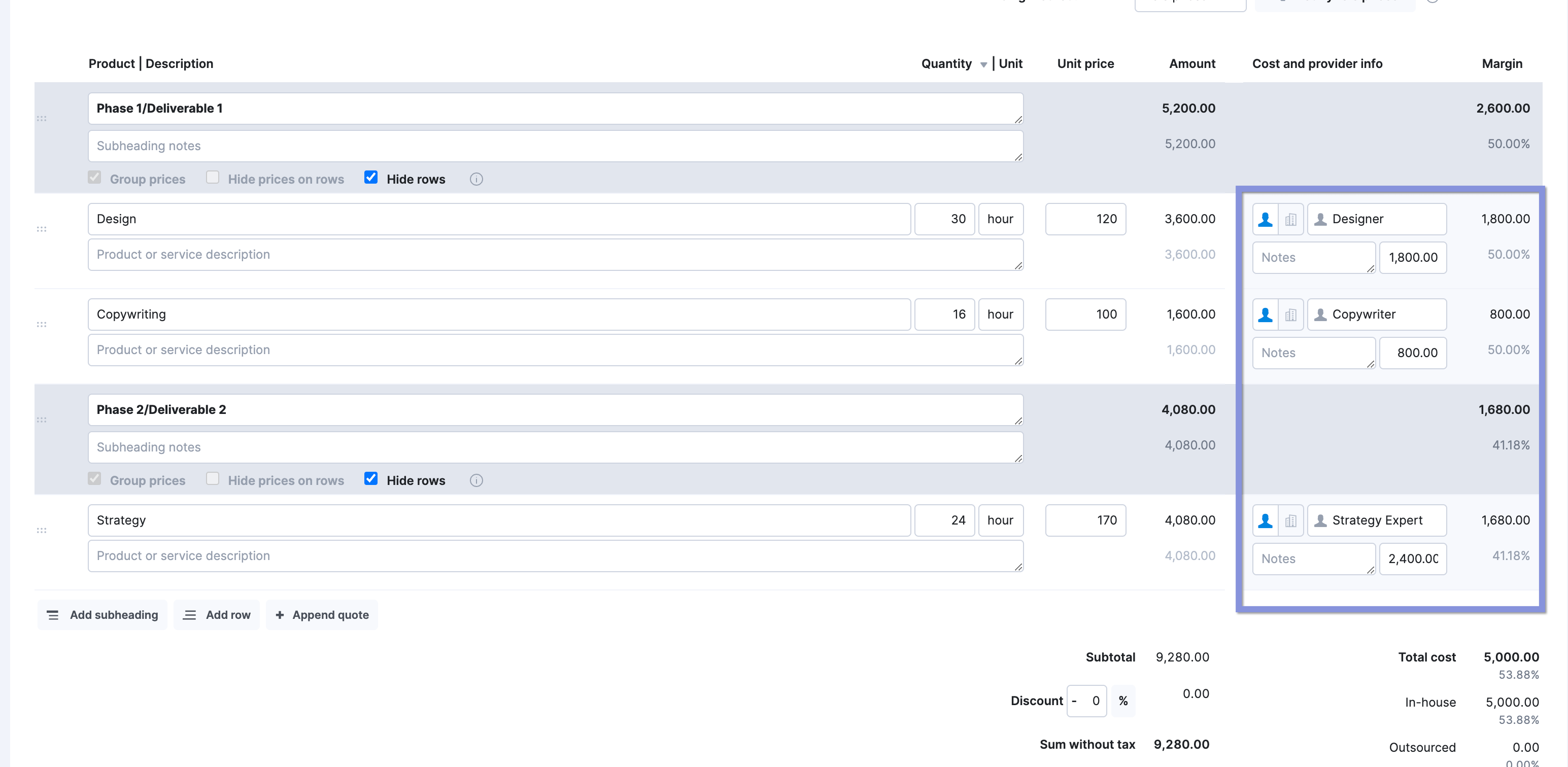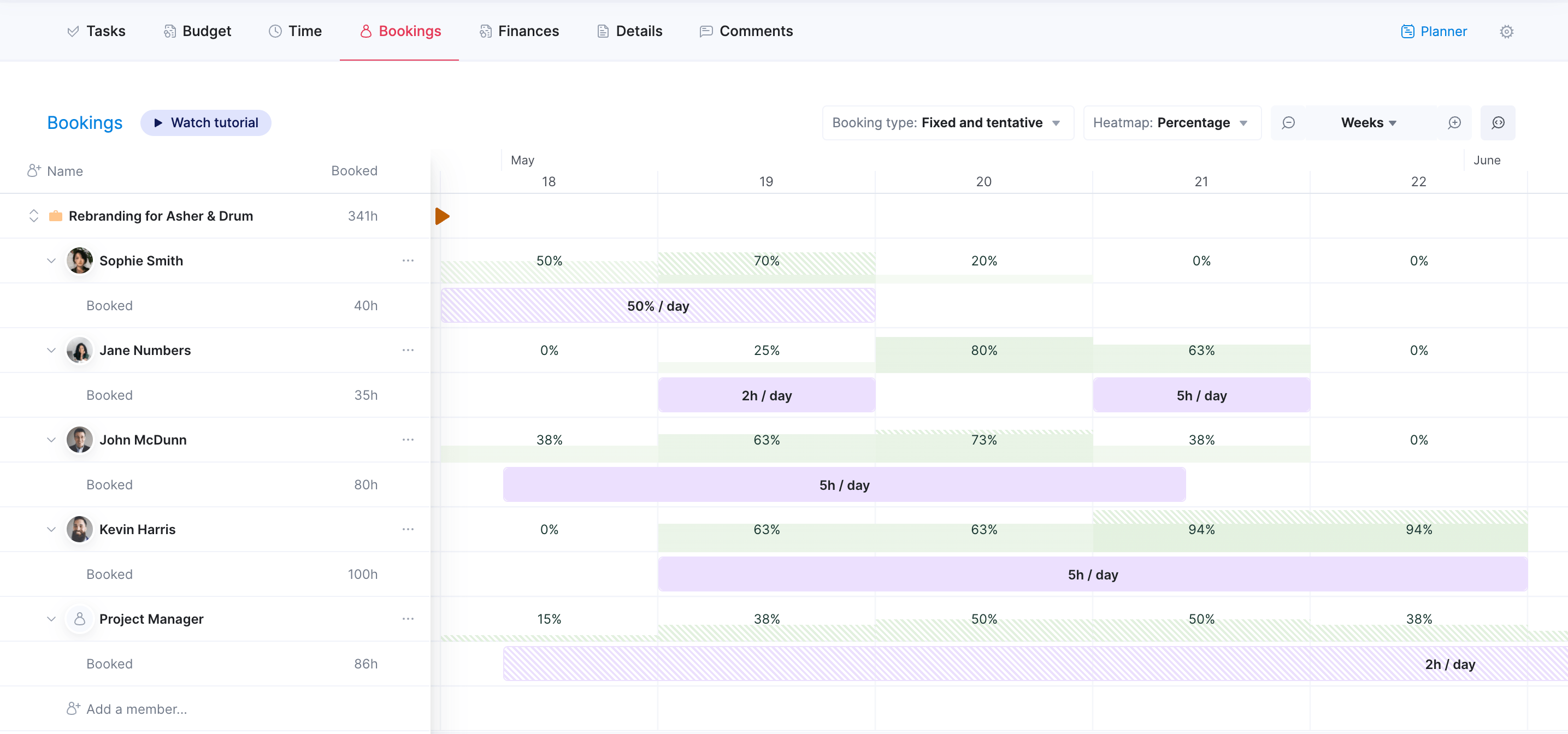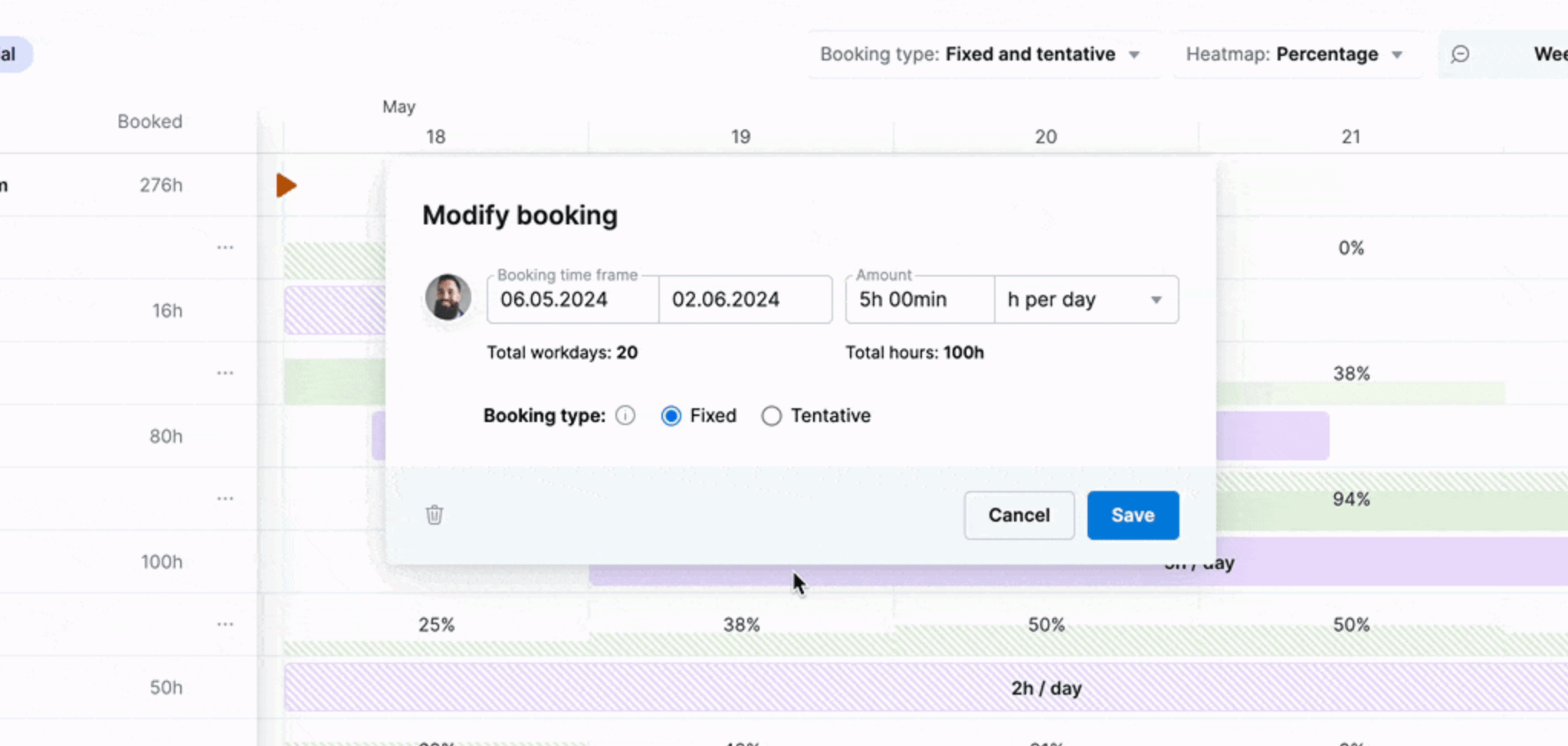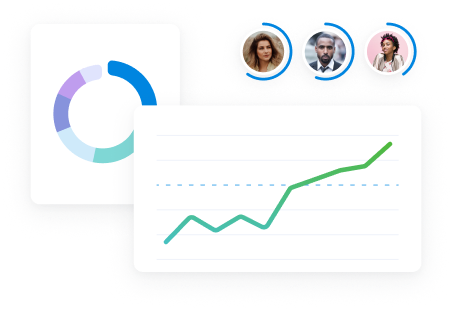What is capacity planning?
Capacity planning means ensuring that there is enough time, people, and specific roles to execute projects successfully. It’s a high-level process that proactively evaluates these factors over weeks or months.
It influences the type and volume of work your team takes on. And it shapes hiring decisions, too.
For example, deciding whether you have enough developers with experience coding in C++ to execute a potential four-month project successfully.
Capacity planning vs resource planning vs resource scheduling
Capacity planning, resource planning, and resource scheduling are all related aspects of project and resource management. But here’s how they differ:
- Capacity planning is your first step. This is how you decide whether you have enough time, team members, and in-house experience to take on certain projects.
- Resource planning is your second step. This involves evaluating your team members’ skill sets and utilization rates to determine who will work on those projects. Like choosing someone to serve as the lead copywriter on a new account.
- Resource scheduling is your third step. Here, you determine which specific tasks team members will work on and when they need to work on them. For example, you might schedule a specific copywriter to draft the first blog post for a new client by the end of the week.
Benefits of capacity planning
Capacity planning helps you say goodbye to chaotic schedules, missed deadlines, and overworked employees. Optimizing your team’s capacity brings a number of benefits, including:
- Greater profitability: When you know your team’s skill sets and availability, you can create realistic timelines and budgets—ones that are less likely to need to be adjusted during the project. This helps improve client satisfaction and retention and improves your project profitability.
- Better cost control: Capacity planning helps you avoid unplanned overtime costs by identifying resource limitations early in the project lifecycle. You can also account for limited bandwidth by proactively adjusting timelines or outsourcing ahead of time.
- Precise revenue forecasting: With a clear understanding of your team’s billable capacity, you can set achievable utilization targets and confidently project revenue based on the planned workload. And your numbers help leadership plan investments, hire employees, and expand the business—without worrying about cash flows.
- Informed hiring decisions: Capacity planning provides clear data on your team’s bandwidth and skills. So, you can use these objective insights to decide if you need to hire, upskill existing staff, or redistribute work. It prevents both understaffing crises and expensive overstaffing.
- Balanced workloads: By tracking your team’s capacity, you can clearly identify who needs more work or less. And redistribute tasks as needed, helping to prevent costly burnout and disengagement.
- Stronger collaboration: Capacity planning clearly defines the roles and resources needed for each project stage. This prevents last-minute scrambling and ensures team members have the support they need from the start.
Capacity planning strategies
Let’s explore three common capacity planning strategies—lag, lead, and match—to help you determine which aligns best with your project needs and risk tolerance.
1. Lag strategy (wait and see)
With the lag strategy, you only hire or add people when demand increases—like refueling a car when the gas tank is empty. This approach aims to keep labor costs as low as possible without causing burnout.
The lag strategy works best for gradual, predictable increases in demand because it allows businesses to add resources incrementally as needed.
With slow, foreseeable growth, companies have time to identify when more than current capacity is required. They can then hire or allocate new resources just in time, minimizing periods of overcapacity and unnecessary costs.
For example, an accounting firm might see a steady 5% increase in clients yearly. They can plan, knowing exactly when to hire an additional accountant. This approach keeps labor costs tightly aligned with actual demand.
However, this strategy struggles with rapid or unpredictable changes.
When unexpected demand spikes occur, there’s a delay between recognizing the need for more resources and actually acquiring them. Hiring and onboarding new staff or reallocating existing resources takes time.
In fast-moving markets, the delay in scaling up could also mean missing out on new business opportunities.
Scoro’s “Utilization report” helps mitigate this risk by letting you monitor your team’s resource utilization in real-time.
It compares your team’s total work capacity (available hours) against the tasks and events they’re scheduled for within a specific timeframe (days, weeks, or months).
This gives you a quick overview of each team member’s utilization percentage, making it easy to see who’s available for new work.

2. Lead strategy (be prepared)
With the lead strategy, you book team members before you officially need them—like stocking up before a storm.
It’s great for handling unexpected demand spikes. And it’s crucial in competitive markets where losing business to rivals is a constant threat. In these environments, there’s intense pressure to exceed client expectations.
The lead strategy suits businesses with seasonal demand, growth ambitions, and a low tolerance for turning away new business opportunities.
For example, imagine a marketing agency before its peak season. Knowing demand will increase, it hires three new team members and expands its freelance roster.
The risk?
Inaccurate resource forecasts can lead to underutilized employees and unnecessary labor costs. You can end up paying people for admin work instead of revenue-generating work.
This directly impacts your profitability—you incur higher costs without a corresponding increase in billable work, which can significantly reduce your profit margins and ROI.
Scoro’s sales pipeline helps you ensure accurate capacity planning by showing all potential deals and their progress through various stages.
This lets you see the number and types of projects likely to move forward, providing a clear picture of upcoming demand.
By having a consolidated view of upcoming projects and their resource needs, you can prioritize projects based on their strategic importance, deadlines, and resource availability.

3. Match strategy (find the middle ground)
The match strategy is a balanced, flexible approach to capacity planning. You combine the cost-saving nature of lag with the proactive planning of lead.
How?
By closely monitoring current demand while forecasting future needs. And continuously tweaking resource levels to avoid underutilization or overbooking.
For example, consider a software development company with changing client needs.
They maintain a stable core team for a consistent workload and use freelancers for flexibility. During busy periods, they bring in more freelancers. In slower times, they reduce freelancer hours without affecting the core team.
While the match strategy is adaptable, it requires more effort than other approaches. You need to manage all project workloads, accurately forecast demand, and clearly understand your team’s utilization rates.
Scoro’s custom dashboards and reporting features help you do just that.
For example, the default “CEO/COO” dashboard provides a comprehensive overview of your company’s performance, showcasing metrics like resource availability over the next 30 days, planned versus actual billable activities, sales conversion rate, and a visual representation of your sales pipeline.

5 steps to implement effective capacity planning
Good capacity planning helps you use your team’s time and skills better. Leading to increased productivity, more accurate project timelines, and higher-quality deliverables.
Here’s how to do it:
Step 1: Create a project priority matrix
Create a project priority matrix for continuous capacity planning. This way, when your team gets busy, you’re not rushing through key decisions on how best to handle potential new work.
Start by using a priority matrix to define your most important projects.
Consider:
- Client value: Which clients bring in the most revenue? Which ones have been clients the longest? Do they have one-off projects or long-term engagements?
- Deadlines: Which projects have the shortest and longest deadlines?
- Profitability: Which types of projects make your company the most money?
- Labor needs: What mix of in-house and outsourced resources do different projects or clients require?
Categorize projects as high or low urgency and high or low importance. Then, communicate this to your team so everyone understands which projects to prioritize if resource conflicts arise.
Supplement your matrix with data to make the most informed decisions on which projects and clients to prioritize.
For example, you can use Scoro’s “Project list” view to analyze what types of projects, clients, and services generated the highest margin for your business
To do this, filter out “Completed” projects from the project list view. Ensure the following columns are enabled by clicking “View” followed by “Data columns”:
- “Gross income”
- “Labor cost”
- “External cost”
- “Project profit”
- “Delivery margin”

Then, you can sort the data or apply the relevant filters to help you analyze profitability in three ways:
Applying relevant filters helps you analyze profitability in three ways.
By projects:
Sort the list by the “Delivery margin” or “Profit” columns to identify high and low-performing projects.
Look for project types that consistently deliver high margins.

By clients:
Click “Group by” at the top of the list and select “Client.” In the “Data columns” drop-down menu, check “Summarize.” This shows which clients provided the best return on investment.

By services:
Open a specific project and go to the “Budget” tab. Locate the “Quoted vs. Actual” table to compare estimated and actual figures for each service.
Identify services with high-profit margins and those underperforming for potential repricing.

Step 2. Forecast resource demand for every incoming project
While you can’t totally predict the future when it comes to project needs, you can get pretty close by integrating capacity planning into your daily workflows.
Why?
Because regularly forecasting resource demand for incoming projects gives you a clear idea of how many people you’ll need and when.
So, you can plan ahead and avoid overbooking or underutilizing team members.
Start by listing all confirmed and potential projects in the pipeline. Include their start and end dates, as well the estimate of the total number of hours needed to complete the project.
This gives you a timeline of when you’ll need people. And helps you identify potential bottlenecks.
Top Tip
Look at data from past projects to create an accurate estimation process. Use it as your foundation. And modify as needed.
Next, break down each project into the specific roles and skills needed.
For example, a website redesign project might need a UX designer with wireframing skills, a full-stack developer proficient in JavaScript, and a project manager.
Scoro’s quoting process sets you up for easy, accurate capacity forecasting, using your entered data to create “tentative bookings” for employees.
These are preliminary time allocations for potential projects. They allow you to visualize potential workloads without committing resources and identify potential scheduling conflicts or capacity issues early.
Head to the “Quotes” module and click “New.”

Here, start building your cost estimate and add which roles or specific team members will be needed and the estimated hours for service.

After you save the quote, click “Create project.”

From here, Scoro automatically creates a project team based on the roles or team members listed in the quote. The quoted hours are automatically converted into tentative bookings.
- Green bars represent the overall utilization percentage for each team member or role across all projects.
- Purple bars represent specific bookings for this project. They either show a percentage of time per day or hours per day.
- Solid-colored bars indicate fixed bookings, while striped bars represent tentative bookings

Top Tip
You can learn more about resource bookings in Scoro by checking out our help center article.
Step 3: Assess the team’s current resource capacity
To plan your resources properly, you need a realistic view of your team’s current capacity.
This serves as your baseline for determining what projects you can realistically take on. And when you might need to bring in additional support.
Create a roster of your team members and their roles (e.g., Senior Designer, Junior Developer). Include their contracted hours and note any part-time arrangements.
Then, determine their available hours on a monthly basis by:
- Calculating their contracted hours per month
- Subtracting estimated non-billable time (meetings, admin tasks) based on past data or company averages
- Accounting for planned absences (vacation, sick leave) from your HR system or team calendar
Suppose a developer has a 40-hour workweek. They spend five hours in meetings and have a week of vacation planned for a month.
- Total hours: 40 hours/week * 4 weeks = 160 hours
- Subtract non-billable time: 5 hours/week * 4 weeks = 20 hours
- Subtract vacation: 1 week = 40 hours
Or, if you’ve created tentative bookings in Scoro, you can look at the utilization heatmap to get an initial overview of the potential demand on your team’s time.
The heatmap compares the resource’s total availability in the given period with their bookings across all projects to calculate their utilization.
For example:
Jane and Dave are Copywriters. Total daily availability for both is 8 hours, which means the maximum total availability for the Copywriter role is 2 x 8 = 16 hours per day.
If Jane already has 6 hours booked and Dave has 4 hours booked, it instantly means the availability of the Copywriter role is now 16 – (6 + 4) = 6 hours.
Now, let’s suppose we also book the Copywriter as a placeholder for 3 hours on Monday. This means the utilization of the Copywriter placeholder on Monday is instantly 50% because the total availability was 6 hours to start with.
The calculation: bookings for the placeholder (3 h) / availability of the role (6 h) = 50%.

You can also check the current availability of the placeholder by clicking on the heatmap.

By visualizing resource availability and tentative bookings, you can get an initial overview of your team’s potential workload. At this stage, review the tentative bookings and identify any obvious imbalances or potential issues.
Top Tip
Your team’s available capacity is based on their working availability in Scoro.
To set up new rules or update schedules, search for Availability in the settings search bar or head to Settings > Work and projects > Availability.
Step 4: Evaluate the overall impact on capacity
Once you understand your team’s available hours and the estimated effort required for each project, it’s time to find the sweet spot between these two.
Say your team consists of four members: Sophie, Kevin, John, and Jane. Sophie and Kevin are full-time, while John and Jane are part-time.
After accounting for meetings and vacations, they collectively have 480 available hours next month.
Your project pipeline includes three website development projects:
- Project A: Estimated 200 hours
- Project B: Estimated 150 hours
- Project C: Estimated 250 hours
The total estimated time needed for those projects is 600 hours, which exceeds your team’s capacity by 120 hours. This indicates potential overbooking and the need to adjust.
Consider the following strategies:
- Re-evaluate estimates: Double-check the estimated hours for each project. Are they realistic based on past experience? Could any tasks be streamlined or automated to reduce the required time?
- Manage client expectations: Communicate proactively with clients about potential delays or resource constraints and explore options for adjusting deadlines or project scope.
- Defer non-essential tasks: Identify any non-essential tasks within the projects that can be postponed to a later date without significantly impacting the overall goals.
- Reallocate: Explore the possibility of outsourcing certain tasks or partnering with other teams/departments to share the workload.
Let’s say kevin is already heavily booked on other projects. But Jane and Sophie have some availability.
You decide to:
- Reassign tasks: You identify tasks in Project C that can be delegated to Jane and Sophie, reducing Kevin’s workload.
- Shift deadlines: You discuss the possibility of extending Project C’s deadline by a week with the client, freeing up time to concentrate on other high-priority tasks
For example, in Scoro’s bookings heatmap, you can adjust the daily workload, or change the booking type, by clicking on the booked slot.
This opens up the booking modal, where you can change the details.

Alternatively, you can adjust the time frame of the booking by simply dragging it.
Step 5: Identify capacity gaps for the following quarters
Once your immediate capacity plan seems set, it’s crucial to assess its long-term viability.
Look ahead at your team’s workload for the coming months to proactively identify and address potential issues before they derail your projects.
You can do this by using the “Utilization report” in Scoro. Go to the “Reports” module and click on “Utilization report.”

Then, adjust the the report to cover the next quarter or a custom period you want to analyze. This gives you a broader perspective on your team’s workload over time.
Timeframes include the next 7, 14, 30, 90 or 36d days.

You can then get a good sense of your team’s capacity for the upcoming months.

You can also filter the report by role by clicking the “All roles” tab and then a specific role to pinpoint specific areas where you might face resource constraints or skill gaps.

Furthering Reading: Employee Utilization Reports 101: Your Ultimate Guide
Scoro’s “Project timeline” view gives you another clear way to visualize your project timelines and avoid potential resource conflicts:
- Yellow bars represent future work that hasn’t started yet, allowing you to see upcoming project demands
- Gray bars indicate work currently in progress
- Blue bars show completed phases, giving you a sense of project history and progress
- Red bars highlight where multiple projects overlap in time—warning signs of potential bottlenecks
Build a strong foundation for successful projects with capacity planning
Capacity planning is key to delivering projects on time and within budget, preventing burnout, and keeping your team engaged. It makes adjusting project timelines, distributing workloads, and ensuring your team has the bandwidth to deliver high-quality work easier.
But capacity planning is only the first step in the resource management puzzle. Next, you need to master resource planning.
Check out our resource planning guide to learn how to improve your staffing choices and balance required expertise with labor costs to keep clients and your company happy.




